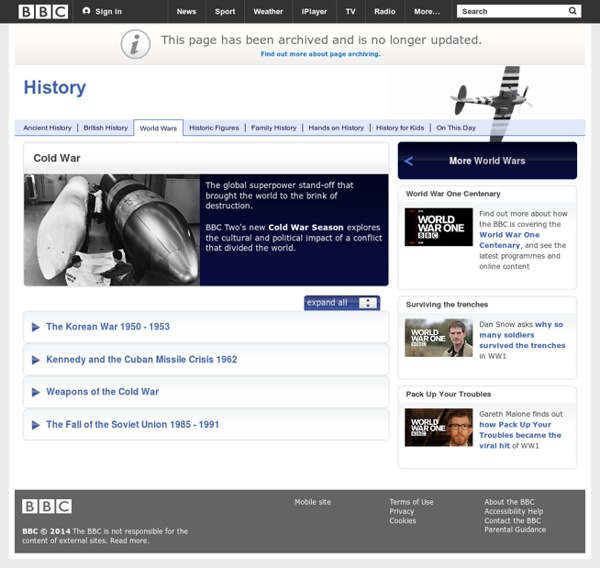



Cold War History - Cold War Almost as soon as he took office, President Richard Nixon (1913-1994) began to implement a new approach to international relations. Instead of viewing the world as a hostile, “bi-polar” place, he suggested, why not use diplomacy instead of military action to create more poles? To that end, he encouraged the United Nations to recognize the communist Chinese government and, after a trip there in 1972, began to establish diplomatic relations with Beijing. Despite Nixon’s efforts, the Cold War heated up again under President Ronald Reagan (1911-2004). Even as Reagan fought communism in Central America, however, the Soviet Union was disintegrating. Access hundreds of hours of historical video, commercial free, with HISTORY Vault.
Cold War The Cold War (1947–1991) During the Cold War, the US conducted around 1,054 nuclear tests by official count, between 1945 and 1992. Seen above is the mushroom cloud of Ivy Mike. The fall of the Berlin Wall, 1989 The Cold War was a state of geopolitical tension between the Soviet Union with its satellite states (the Eastern Bloc), and the United States with its allies (the Western Bloc) after World War II. A common historiography of the conflict begins with 1946, the year U.S. diplomat George F. The Cold War split the temporary wartime alliance against Nazi Germany, leaving the Soviet Union and the United States as two superpowers with profound economic and political differences. A neutral bloc arose with the Non-Aligned Movement, which sought good relations with both sides. The Cold War and its events have left a significant legacy. Origins of the term Looking at the world as a whole, the drift for many decades has been not towards anarchy but towards the reimposition of slavery... U.S.
US History Timeline: Cold War Before 1600 | 1600 - 1700 | 1700 - 1800 | 1800 - 1900 | 1900 - 2000 | American Revolution Timeline | Cold War Timeline 1945 Feb. Yalta Conference May World War II ends in Europe. Aug. U.S. drops an atomic bomb on Hiroshima, Japan. Potsdam Conference - Truman - Stalin and British divide up Europe 1946 Jan. 1947 Jan. March Truman Doctrine announced. 1948 June Berlin Airlift begins (ends May 19, 1949) 1949 April North Atlantic Treaty Organization (NATO) established. Aug. Oct. 1950 June U.S. and other U.N. members fight North Korean forces. (the Korean War ends July 27, 1953) 1953 Aug. 1954 June U.S. sponsored coup overthrows Guatemalan government. Sept. 1955 May Warsaw Pact formed. July First Summit Meeting between President Dwight Eisenhower and Premier Nikita Khrushchev. 1956 Nov. 1957 Oct. 1959 Feb. 1961 Apr. Aug. 1962 June Sino‑Soviet Conflict begins. Oct. 1964 Oct. 1965 April U.S. sends troops to the Dominican Republic. Aug. 1968 Aug. 1972 Feb. 1973 Sept. 1975 Apr. 1976 Feb. 1979 Jan. Dec. Sept.
Soviet Officer Stanislav Petrov, 'The Man Who Saved The World,' Dies At 77 Stanislav Petrov, a former Soviet military officer, poses at his home in 2015 near Moscow. In 1983, he was on duty when the Soviet Union's early warning satellite indicated the U.S. had fired nuclear weapons at his country. He suspected, correctly, it was a false alarm and did not immediately send the report up the chain of command. toggle caption Pavel Golovkin/AP Stanislav Petrov, a former Soviet military officer, poses at his home in 2015 near Moscow. Stanislav Petrov was a lieutenant colonel in the Soviet Union's Air Defense Forces, and his job was to monitor his country's satellite system, which was looking for any possible nuclear weapons launches by the United States. He was on the overnight shift in the early morning hours of Sept. 26, 1983, when the computers sounded an alarm, indicating that the U.S. had launched five nuclear-armed intercontinental ballistic missiles. It was already a moment of extreme tension in the Cold War. Petrov had to act quickly. He had guessed correctly.
Cold War Hot Links: Web Sorces Relating to the Cold War Cold War Hot Links These links are to webpages which other people have created and like most things on the net, they run the entire spectrum of political thought and vary greatly in quality. Nonetheless, they do provide web- surfers with some interesting views and information on the Cold War and the National Security State. Some Cold War Web Resources Scanned FOIA Anthropology Documents About this page and what I'm up to. I'm an anthropologist who is using the Freedom of Information Act, archival sources and interviews to write an historical account of the influences of the Cold War on American anthropology.
The Cold War The webserver at Alpha History tells us you’re using an adblocking tool, plug-in or browser extension on your computer or network. We understand that many people don’t like web-based advertising. Ads on websites can often be irrelevant, distracting and ‘in your face’. Without ads, however, our website would not exist – or it would not be free. Ads are how we fund the creation and delivery of our content. If you would like to use our website and its resources, please disable your adblocker or whitelist our website. To access the Alpha History website, please complete one of the following steps: * Disable or deactivate your adblocking software, tool or plug-in. * Whitelist our top level domain (alphahistory.com) in your adblocking software. Thank you for your understanding. Have a nice day! Alpha History staff